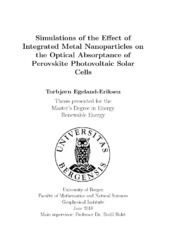| dc.contributor.author | Egeland-Eriksen, Torbjørn | |
| dc.date.accessioned | 2018-09-10T14:18:44Z | |
| dc.date.available | 2018-09-10T14:18:44Z | |
| dc.date.issued | 2018-09-08 | |
| dc.date.submitted | 2018-09-07T22:00:02Z | |
| dc.identifier.uri | https://hdl.handle.net/1956/18457 | |
| dc.description.abstract | The negative effects from the use of fossil fuels that are evident in the ongoing climate change and pollution challenges necessitates a shift from fossil fuels to renewable energy technologies. The most promising of these is probably photovoltaic solar cells, and one of the most promising photovoltaic technologies is perovskite solar cells. These are a type of thin film solar cells that has shown the most rapid increase in power conversion efficiency of any photovoltaic technology in history. They are also relatively cheap and easy to produce, as well as light-weight and flexible, which makes them a promising candidate for building integrated solar cells. However, they are still in the research stage and require further development to achieve long-term stability and to scale up to commercial sizes. Plasmonic effects that arise from the integration of metal nanoparticles within the perovskite solar cells is a very promising method for increasing the power conversion efficiency of these solar cells. This thesis used computer simulations to investigate how these plasmonic effects alter the fraction of light that is absorbed by the solar cell, since light absorptance is the most important factor affecting the power conversion efficiency. Close to 400 simulations are performed using the Lumerical FDTD Solutions software. The materials used for the nanoparticles are gold, silver, aluminum and platinum, and the shapes used are spheres, cubes, rods (cylinders) and pyramids. Simulations using core-shell particles with a silicon dioxide shell, and simulations where the position and number of nanoparticles is adjusted are also performed. Material data from research articles are imported and used for the various layers of the solar cell structure. The absorptance increases in almost all the simulations where nanoparticles are used. Relatively large nanoparticles usually show the highest absorptance. The thinnest solar cell, where the thickness of the active perovskite layer is 200 nm, show a larger increase in absorptance relative to the reference solar cell without nanoparticles than the thicker solar cell (500 nm perovskite) does. These two thicknesses (200 and 500 nm) for the perovskite layer was used in the simulations because those are the lower and upper limit of the thicknesses that are usually used in published research literature on the topic, and because the 200 nm layer showed the highest absorptance per nm while the 500 nm layer showed the highest total absorptance. The largest total absorptance was achieved by using a platinum nanoparticle shaped like a pyramid in the thickest solar cell, while the largest relative absorptance increase was achieved by using a platinum nanoparticle shaped like a cube in the thinnest solar cell. The former achieved a total absorptance of 0.861 (86.1% of incident photons were absorbed), while the latter achieved a 52.9% increase in absorptance relative to the reference solar cell without nanoparticles. However, the reduced price and higher availability of aluminum could make it more beneficial to replace the platinum nanoparticles with aluminum, which resulted in a total absorptance of 0.848 (as opposed to 0.861 for platinum) for the thickest solar cell and a relative absorptance increase of 47.6% (as opposed to 52.9% for platinum) for the thinnest solar cell. All simulation results in this thesis strongly indicate that the integration of metal nanoparticles in perovskite solar cells will increase the absorptance of the solar cell, and consequently increase the power conversion efficiency. Utilizing plasmonic effects therefore seem to be a very promising route towards creating high-efficiency thin film solar cells. | en_US |
| dc.language.iso | eng | eng |
| dc.publisher | The University of Bergen | en_US |
| dc.subject | simulations | eng |
| dc.subject | Lumerical | eng |
| dc.subject | photovoltaic | eng |
| dc.subject | absorptance | eng |
| dc.subject | thin-film | eng |
| dc.subject | perovskite | eng |
| dc.subject | solar cells | eng |
| dc.subject | Absorpsjon | nob |
| dc.subject | Energiomvandling | nob |
| dc.subject | Fornybar energi | nob |
| dc.subject | Nanopartikler | nob |
| dc.subject | Solceller | nob |
| dc.title | Simulations of the Effect of Integrated Metal Nanoparticles on the Optical Absorptance of Perovskite Photovoltaic Solar Cells | en_US |
| dc.type | Master thesis | |
| dc.date.updated | 2018-09-07T22:00:02Z | |
| dc.rights.holder | Copyright the Author. All rights reserved | en_US |
| dc.description.degree | Masteroppgave i energi | en_US |
| dc.description.localcode | MAMN-ENERG | |
| dc.description.localcode | ENERGI399 | |
| dc.subject.realfagstermer | https://data.ub.uio.no/realfagstermer/c011958 | |
| dc.subject.realfagstermer | https://data.ub.uio.no/realfagstermer/c000860 | |
| dc.subject.realfagstermer | https://data.ub.uio.no/realfagstermer/c014049 | |
| dc.subject.realfagstermer | https://data.ub.uio.no/realfagstermer/c012789 | |
| dc.subject.realfagstermer | https://data.ub.uio.no/realfagstermer/c007538 | |
| dc.subject.nus | 752903 | eng |
| fs.subjectcode | ENERGI399 | |
| fs.unitcode | 12-44-0 | |
